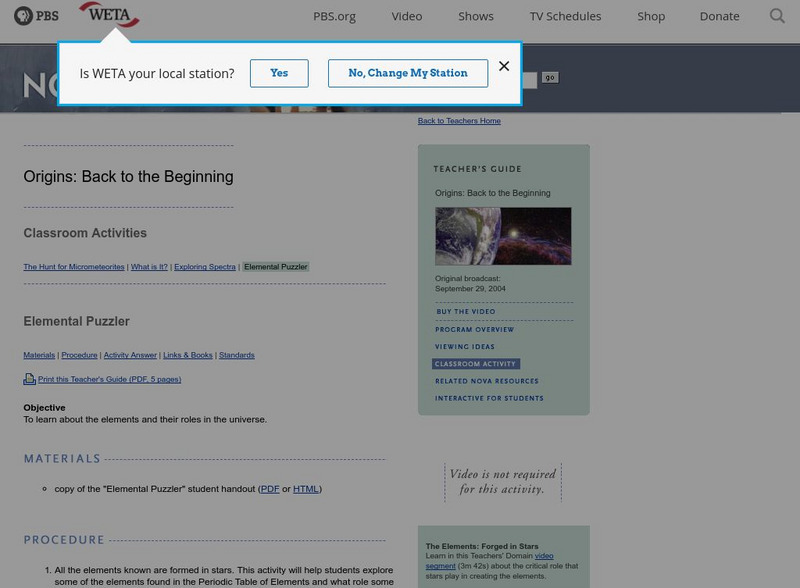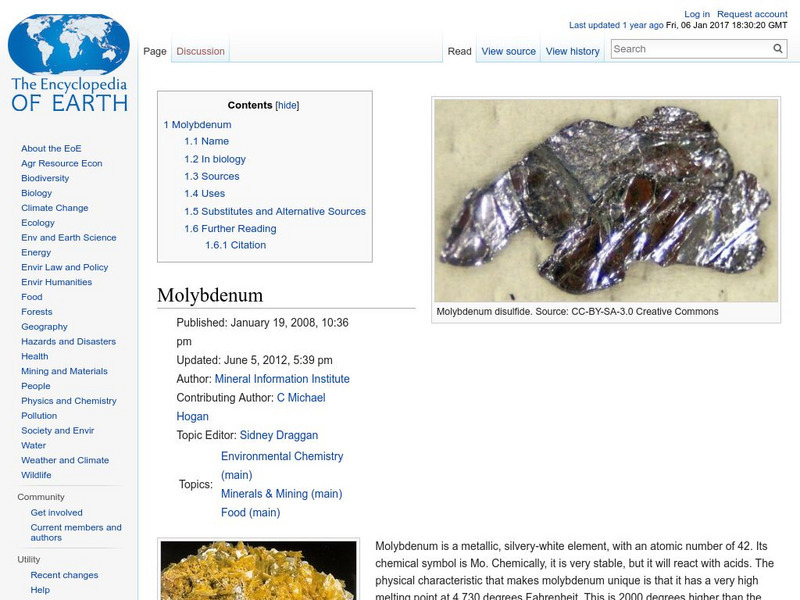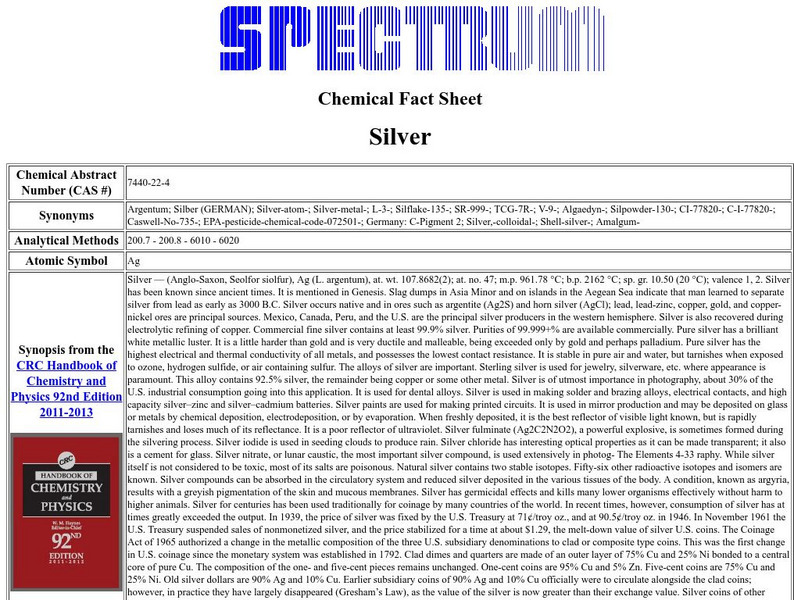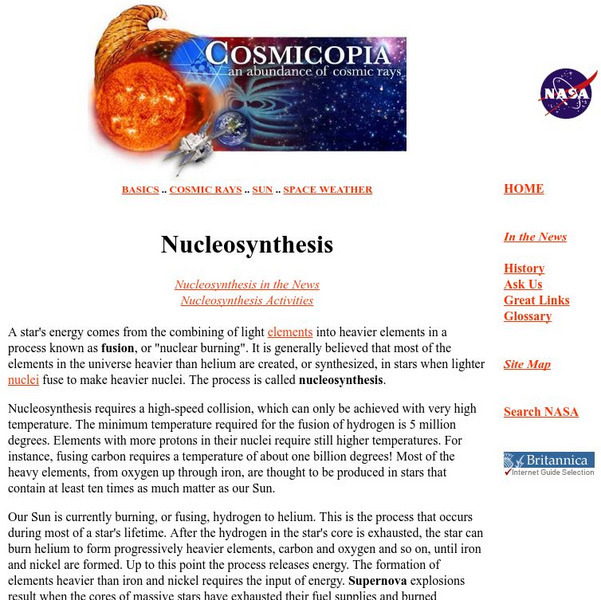Science Struck
Science Struck: Metalloids in the Periodic Table
Discusses the history and organization of the periodic table, where the metalloids fit in, and their properties. Includes color-coded periodic table of elements.
TeachEngineering
Teach Engineering: Engineering and the Periodic Table
Students learn about the periodic table and how pervasive the elements are in our daily lives. After reviewing the table organization and facts about the first 20 elements, they play an element identification game. They also learn that...
TED Talks
Ted: Ted Ed: Ytterbium: Periodic Table of Videos
The team at periodicvideos has created a TED-Ed Lesson for every element of the periodic table. What better way to talk about Ytterbium than by doing it from the very place it was discovered - Ytterby in Sweden! [3:36]
Utah Education Network
Uen: The Periodic Table and the Universe
Students will apply the atomic number of elements on the periodic table to the origin of heavy elements in the star cycle.
PBS
Pbs Learning Media: Pyrotechnics: It's Elemental
In this interactive periodic table from the NOVA Web site, find out the role of various elements in making fireworks.
Science Struck
Science Struck: Labeled Periodic Table of Elements With Names
Describes the organization of the periodic table of elements and the different groups in it.
Science Struck
Science Struck: Electron Configuration Chart for the Periodic Table
Explains the theoretical basis of electron configuration and presents a table of all 118 elements with their symbols, number of electrons, and electron configurations.
BBC
Bbc: Gcse Bitesize: Predicting Chemical Reactions
This lesson focuses on predicting chemical reactions using The Group 1 elements in the Periodic Table are known as the alkali metals. They include lithium, sodium and potassium, which all react vigorously with air and water. It provides...
Famous Scientists
Famous Scientists: Glenn Seaborg
Learn about Glenn Seaborg, the man who took part in the discovery of ten of the periodic table's chemical elements, and was awarded the Nobel Prize in Chemistry in 1951.
PBS
Pbs Teachers: Origins: Back to the Beginning
Explore the elements found in the Periodic Table of Elements and what role some of them play in the universe. Test your knowledge of the elements and the organization of the table by completing a puzzle.
Ducksters
Ducksters: Chemistry for Kids: Elements: Post Transition, Poor, Other Metals
Kids learn about the post-transition, poor, and other metals of the periodic table. Which elements are in this group. Properties, similarities, and other facts.
Ducksters
Ducksters: Chemistry for Kids: Elements: Nonmetals
Kids learn about the nonmetals of the periodic table. Which elements are in this group. Properties, similarities, and other facts are found on this site.
Dartmouth College
Dartmouth College: Chem Lab: Welcome to General Chemistry Laboratory!
Geared towards helping Dartmouth College students starting General Chemistry Laboratory, this site offers resources important for anyone in the lab. Learn why you should keep a lab notebook and how to keep yourself and others safe. This...
Science Struck
Science Struck: Halogen Family
Read about the non-metallic elements in the halogen family, what their chemical and physical properties are, their uses, and some interesting facts about them.
Other
Atoms in Motion: All Matter Is Made of Atoms
Atoms are very, very small. Atoms are so small that it is often said that there are as many atoms in a single grain of sand as there are grains of sand on all of the world's beaches - certainly a difficult thing to prove, but you get the...
Encyclopedia of Earth
Encyclopedia of Earth: Nitrogen
Information about the element, Nitrogen, atomic number 14. Covers common chemical transformations, its physical properties, atomic properties, how abundant it is on the Earth, and details about health-related regulations. Also discusses...
Encyclopedia of Earth
Encyclopedia of Earth: Molybdenum
Information about the metallic element, Molybdenum, atomic number 42. It is unique in having an extremely high melting point. Covers its discovery, its biological importance, its physical and atomic properties, how abundant it is on the...
Encyclopedia of Earth
Encyclopedia of Earth: Lead
Information about the heavy metal, Lead, atomic number 82. Gives some interesting historical details about lead's use in the past. Covers physical properties, atomic properties, how abundant it is on the Earth, and details about...
Encyclopedia of Earth
Encyclopedia of Earth: Physics & Chemistry: Calcium
Information about the element, Calcium, atomic number 20. Covers physical and atomic properties, sources, its role in geochemical cycles, how abundant it is on the Earth, its isotopes, some compounds of calcium, and its importance to...
Florida-Spectrum Environmental Services
Florida Spectrum: Chemical Fact Sheet: Silver
This site provides elemental information which may not be found in many other sites. Here you can find historical information, common uses and even the approximate going price for a gram of the element.
NASA
Nasa: Cosmicopia: Nucleosynthesis
NASA's Cosmicopia illustrates the process of element creation in the universe.













